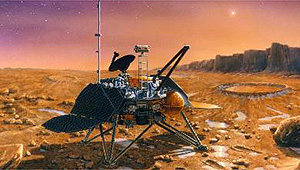NASA has been busy searching for the ideal landing site for years and has already checked hundreds of different sites for the two vehicles that will arrive at the Red Planet in early 2004. Last spring, they almost found the right place to land, but then data arrived that made it clear that the location was not possible for the mission

A NASA spacecraft finds its way to Mars
Finding a place to land on Mars should not be a particularly difficult task. The surface of the planet is as big as the area of all the Earth's continents combined. But unfortunately, spacecraft, built of delicate parts, are difficult to impossible to land on the rocks that cover Mars.
NASA has been busy searching for the ideal landing site for years and has already checked hundreds of different sites for the two vehicles that will arrive at the Red Planet in early 2004. Last spring, the right place to land was almost found, but then data arrived that made it clear that the location was not possible for the mission.
The operation may be much simpler if you are not coming for engineering or research purposes, but only for tourism. In such a case, you will arrive on a commercial spacecraft flight and you can simply choose one of the 1,470 places on Mars that the inhabitants of the Earth have managed to name, or the countless places that do not yet have one. The magazine "Wired" lays out the most diverse vacation spots and you can choose the cliff that is much higher than any cliff on earth, or the highest volcano in the solar system or maybe just walk along what was once the water line of an ancient ocean.
Skiing and dizziness
Just like Paris and London, Mars also has a group of fans or just scientists who are willing to tell about the tourist attractions that should not be missed in any way, if you happen to be around.
The American scientist, Barbal Lucita, recommends the "western edge of Kandor Kazma": "The view from the place reaches 150 km. The landslide nearby can cause dizziness and serve as an excellent area for skiing."
William Shanter, an actor from "Star Trek" recommends the "edge of the northern ice dome": "This spot will provide me with drinking water and the ability to practice ice hockey. I will be completely alone, without Starbucks and McDonald's, without emergency services in case I get injured when I jump into space and land only after 5.5 minutes."
Carol Stoker, a scientist at NASA, recommends the "Newton Crater": a magnetic strip, which indicates that its crust was formed very early. Besides, there are channels and ravines on the slopes of the mountain. The sediments in the gorges are a good place to find evidence that the place contains a biosphere, that is, a place where life is found."
Robert Zubrin, president of the Mars Society, recommends a place called "Opir Plenum": it is located north of the intersection of Cuprite Kazma and Capri Kazma. It is a very diverse region in its geology and has an extremely dramatic topography. I set my novel, "First Landing", in this area.
Buzz Aldrin, former astronaut with an ever more topical recommendation: I would go to Olympus Mons, but if you can't find a good spot to land in the area, I recommend the Korolev Crater, where there is a lot of ice and caves, which will protect you from radioactive radiation."
Olympus - the highest mountain
The volcanoes of Mars are among the largest in the solar system. The highest of them, Olympus (pictured), is an extinct volcano whose area is as large as the entire state of Israel. Its height is over 20 km (Everest's height is less than half of that).
These giant volcanoes are quite young - 2 billion to XNUMX billion years old. On Olympus, signs of a lava flow, which occurred tens of millions of years ago, are visible.
These mountains grew because there is no continental movement on Mars. The volcanic areas remain above the lava reservoirs for a longer period of time than on Earth, therefore they have grown to their enormous dimensions. Most of the volcanoes are in the Tharsis region, in the northern half of Mars.
